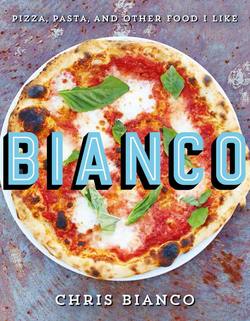Читать книгу Bianco: Pizza, Pasta and Other Food I Like - Chris Bianco - Страница 14
ОглавлениеPIZZA BIANCOVERDE
At the pizzeria, when I sat down to write out the final menu, I wanted there to be a balance of three pies with tomato sauce and three without. At the time, white pies weren’t really common in the States, at least outside the East Coast, where white pizza—typically a rubbery stretch of overcooked mozzarella pocked with scoops of deli ricotta—was a standard in most slice joints. But I had had beautiful white pies in Rome, and had a lasting memory of a particularly killer quattro formaggi—the classic four-cheese pizza—that was rich but not heavy. So at first I thought I’d do a quattro formaggi too. But after thinking about my setup—How much room did I have on my line? How many of the cheeses could I reach quickly as I cooked? And how many great, high-quality Italian cheeses were readily available in Phoenix back then?—I settled on a three-cheese pizza with mozzarella, Parmigiano-Reggiano, and fresh ricotta. Three Italian classics, but familiar to Americans. Three significant textures that work well together and taste delicious: the pliant quality of the mozzarella, the fatty sharpness of the Parmigiano, and the yielding creaminess of ricotta. Then I’d offset the buttery dairy goodness of the cheeses with barely wilted peppery arugula—a bright hit of something green and fresh.
With this pizza—with all white pies, really—the cut of the cheese is of paramount importance, because how you break down your cheese will determine its texture once it is cooked. This pie is all about the subtle textural differences among the cheeses, which underscore the differences in their flavors. You want to tear the mozzarella into cubes that will melt into shreds of cheese that have some chew. For the Parmesan, use the large holes on a box grater; if the cheese is finely grated, it will break down too quickly and toughen. For the ricotta, you don’t need to break it down, of course, but you do want to think about the size of the spoon you use to dollop it on the pizza. I like to use a teaspoon so there are substantial but not overwhelming moments of creaminess.
For the Biancoverde, I like a younger Parmigiano, in the 24-to-36-month range. A Parmigiano aged for 2 years has a great maturity and all that awesome developed flavor, but it also still has good moisture content. I love older Parms—don’t get me wrong—but I think they’re better for straight-up eating rather than cooking.
Makes one 10-inch pizza
One ball Pizza Dough, rested and ready to shape
1 ounce Parmigiano-Reggiano, coarsely grated
1 ounce fresh mozzarella, torn into cubes
2 tablespoons whole-milk ricotta, drained of whey
A good handful of wild or baby arugula
Extra virgin olive oil, for drizzling
Coarse sea salt and freshly ground black pepper
Position a rack in the lower third of the oven (remove the rack above it) and place a pizza stone on it. Turn up your oven to its maximum setting and let that baby preheat for a solid hour.
Once the oven is preheated, grab a pizza peel and give it a nice, light dusting of flour. Shape the dough as directed and set the dough on the floured peel. Jerk the peel to make sure it’s not sticking. If it is, lift the dough and dust the underside with extra flour (or, if no one is looking, blow under it very gently). Tuck and shape it until it’s a happy circle.
Scatter the Parmigiano evenly over the surface of the dough, stopping about ¾ inch—a fat thumb’s width—from the edges. Scatter the mozzarella over the Parmigiano. Finally, gently spoon on the ricotta in small dollops, aiming for a nice even balance.
Open the oven and, tilting the peel just slightly, give it a quick shimmy-shake to slide the pizza onto the pizza stone. Bake the pizza for 10 to 15 minutes, until the crust is crisp and golden brown. White pizzas like this have a tendency to set more quickly, so this may take slightly less time in the oven than most pizzas.
Remove the pizza with the peel and immediately scatter the arugula evenly over the top. The heat of the pizza will wilt the greens just enough to make them tender, but they will still hold their shape. Finish the pizza with a drizzle of beautiful olive oil and a few pinches of coarse salt and turns of black pepper. Enjoy immediately!
